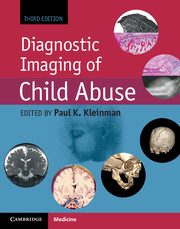Book contents
- Frontmatter
- Dedication
- Contents
- List of Contributors
- Editor’s note on the Foreword to the third edition
- Foreword to the third edition
- Foreword to the second edition
- Foreword to the first edition
- Preface
- Acknowledgments
- List of acronyms
- Introduction
- Section I Skeletal trauma
- Chapter 1 The skeleton: structure, growth and development, and basis of skeletal injury
- Chapter 2 Skeletal trauma: general considerations
- Chapter 3 Lower extremity trauma
- Chapter 4 Upper extremity trauma
- Chapter 5 Bony thoracic trauma
- Chapter 6 Dating fractures
- Chapter 7 Differential diagnosis I: diseases, dysplasias, and syndromes
- Chapter 8 Differential diagnosis II: disorders of calcium and phosphorus metabolism
- Chapter 9 Differential diagnosis III: osteogenesis imperfecta
- Chapter 10 Differential diagnosis IV: accidental trauma
- Chapter 11 Differential diagnosis V: obstetric trauma
- Chapter 12 Differential diagnosis VI: normal variants
- Chapter 13 Evidence-based radiology and child abuse
- Chapter 14 Skeletal imaging strategies
- Chapter 15 Postmortem skeletal imaging
- Section II Abusive head and spinal trauma
- Section III Visceral trauma and miscellaneous abuse and neglect
- Section IV Diagnostic imaging of abuse in societal context
- Section V Technical considerations and dosimetry
- Index
- References
Chapter 6 - Dating fractures
from Section I - Skeletal trauma
Published online by Cambridge University Press: 05 September 2015
- Frontmatter
- Dedication
- Contents
- List of Contributors
- Editor’s note on the Foreword to the third edition
- Foreword to the third edition
- Foreword to the second edition
- Foreword to the first edition
- Preface
- Acknowledgments
- List of acronyms
- Introduction
- Section I Skeletal trauma
- Chapter 1 The skeleton: structure, growth and development, and basis of skeletal injury
- Chapter 2 Skeletal trauma: general considerations
- Chapter 3 Lower extremity trauma
- Chapter 4 Upper extremity trauma
- Chapter 5 Bony thoracic trauma
- Chapter 6 Dating fractures
- Chapter 7 Differential diagnosis I: diseases, dysplasias, and syndromes
- Chapter 8 Differential diagnosis II: disorders of calcium and phosphorus metabolism
- Chapter 9 Differential diagnosis III: osteogenesis imperfecta
- Chapter 10 Differential diagnosis IV: accidental trauma
- Chapter 11 Differential diagnosis V: obstetric trauma
- Chapter 12 Differential diagnosis VI: normal variants
- Chapter 13 Evidence-based radiology and child abuse
- Chapter 14 Skeletal imaging strategies
- Chapter 15 Postmortem skeletal imaging
- Section II Abusive head and spinal trauma
- Section III Visceral trauma and miscellaneous abuse and neglect
- Section IV Diagnostic imaging of abuse in societal context
- Section V Technical considerations and dosimetry
- Index
- References
Summary
Introduction
Accurate dating of fractures is critical in cases of suspected child abuse (1–8). The ability of medical professionals to assess the veracity of the history provided depends on the clinical and radiologic assessment of the presenting injury or injuries. If, for example, a single injury to a localized portion of the extremity is alleged to have occurred but multiple sites of subperiosteal new bone formation (SPNBF) and/or callus are seen on radiographs, medical providers should become suspicious and initiate further investigation. However, if the severity of the alleged injury correlates with clinical and radiographic findings and all evidence suggests that the fracture is acute, the suspicion of abuse may never arise. It is clear that the ability of the radiologist and the clinician to assess the age of bony injury is critical to a determination of suspected child abuse. The forensic requirements to establishing responsibility and determining the need for intervention by child protection agencies rest strongly on the assessments of the clinician and the radiologist regarding the nature and timing of injury. Accurate fracture dating can aid in the identification and exclusion of potential abusive perpetrators. In criminal proceedings, the requirement to assign age estimates to fractures and to determine if there have been multiple episodes of abuse may have important implications. The presence of prior injuries may influence critical decisions regarding how defendants may be charged, how a prosecution may procede, the jury verdict, and the penalties to a convicted abuser (Fig. 6.1) (9).
- Type
- Chapter
- Information
- Diagnostic Imaging of Child Abuse , pp. 208 - 216Publisher: Cambridge University PressPrint publication year: 2015
References
- 8
- Cited by



